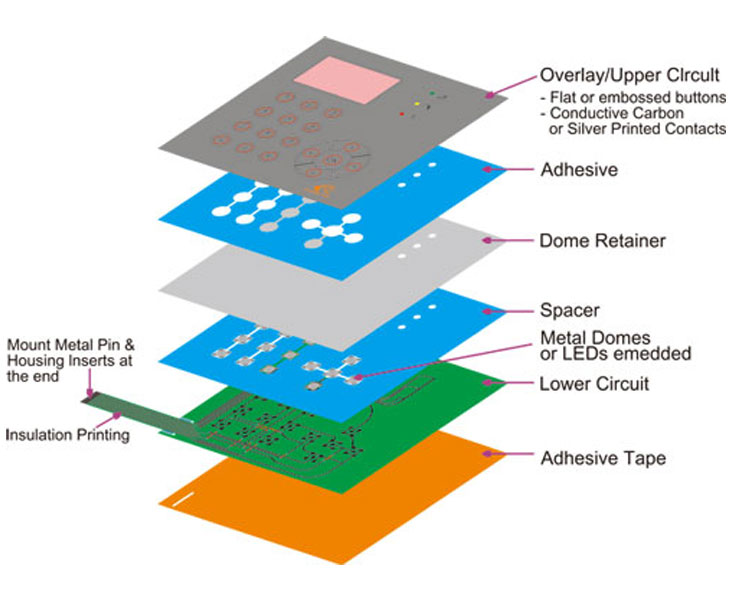Reliable Products from a Membrane Switch Manufacturer You Can Rely On
Comprehending the Importance of Membrane Switch in Modern Electronics and Their Applications
Membrane switches act as an important component in contemporary electronic devices, providing an effective user interface for individual communication. Their adjustable and lightweight nature makes them ideal for a variety of applications across varied sectors. Comprehending their key parts and advantages can provide insights right into their expanding relevance. As technology proceeds to advance, the development of Membrane switches questions concerning their future applications and design innovations. What lies in advance in this dynamic field?

What Are Membrane Buttons?
Membrane switches are necessary components in modern-day electronic devices, working as customer interfaces that promote communication between devices and customers. These switches consist of numerous layers, consisting of a visuals overlay, an adhesive layer, and a circuit layer, every one of which interact to create a resilient and useful user interface. The design enables a level, inconspicuous remedy that can be customized regarding dimension, form, and aesthetic look, making them appropriate for different applications, from consumer electronics to clinical tools. The responsive comments provided by Membrane changes improves customer experience, while their resistance to dust and wetness makes them perfect for challenging settings. Moreover, Membrane buttons can include features such as backlighting and printed graphics, additionally expanding their usability. Their flexibility and robustness make them a favored choice in industries where dependability and simplicity of usage are vital, eventually adding to the seamless operation of modern electronic tools.
Key Components of Membrane Changes
While different parts contribute to the functionality of a membrane layer switch, 3 primary layers play significant roles in its layout and operation. The leading layer, typically made from a durable polymer, functions as the interface for individual interaction, typically including published graphics and icons. Under this is the spacer layer, which preserves the necessary distance in between the top layer and the circuit layer. This spacer layer warranties that the switch activates just when pressed, preventing unintended inputs. Lastly, the circuit layer consists of conductive traces that finish the electrical circuit when the leading layer is depressed. These traces can be made from numerous materials, consisting of copper or silver. Together, these parts develop a reliable and robust gadget that is compact and flexible, suitable for a variety of electronic applications, from household home appliances to clinical gadgets. Comprehending these crucial components is essential for appreciating the total performance of Membrane switches.
Benefits of Utilizing Membrane Changes

Membrane Switch Production Process
Comprehending the Membrane button manufacturing procedure reveals the complex steps entailed in creating these vital elements. The process normally begins with the style stage, where designs and requirements are produced making use of specialized software application. Following this, the graphic overlay is printed on an adaptable substratum, often utilizing high-resolution printing techniques to ensure clarity and precision.Next, the glue layers are used, which offer to bond the different elements together. The circuit layers, made from conductive inks or materials, are then published onto a different substrate. These layers are thoroughly aligned and laminated flooring to create a useful switch.After setting up, the buttons undergo checking to validate performance and durability. Quality assurance procedures are applied throughout the procedure to recognize and correct any kind of problems. Finally, the completed Membrane buttons are packaged and planned for distribution, prepared to meet the needs of modern electronic applications.
Applications of Membrane Switches Over in Different Industries
Membrane buttons are increasingly utilized throughout numerous sectors, particularly in clinical tools and consumer electronic devices. In the medical area, they supply trustworthy control user interfaces for tools that require exact procedure. Likewise, in customer electronics, these switches improve individual interaction by providing receptive and streamlined user interfaces.
Medical Tools Control
Various modern medical tools make use of Membrane buttons for streamlined procedure and improved customer communication. These switches offer a reputable, long lasting interface for a variety of applications, consisting of analysis devices, individual surveillance systems, and surgical instruments. Their personalized designs permit for specific layouts that can fit the distinct demands of health care specialists, making certain intuitive navigation and effective access to necessary functions. In addition, Membrane buttons are resistant to pollutants, making them ideal for clean and sterile environments. The tactile feedback they supply can boost individual self-confidence, minimizing the danger of errors during essential medical procedures. Generally, the assimilation of Membrane switches in medical equipment significantly contributes to enhanced operational performance and client safety in medical care settings.
Consumer Electronic Devices Interfaces
In the domain of consumer electronics, Membrane switches play a critical role in improving individual interfaces throughout a wide variety of gadgets. These switches are integral to products such as remote controls, microwaves, and video gaming consoles, providing a effective and easy helpful site to use user interface. Their layout enables a seamless combination of graphics and performance, allowing producers to create sleek, modern-day appearances without jeopardizing use. Membrane switches are likewise understood for their longevity, often withstanding extensive usage and exposure to numerous ecological problems. Furthermore, they can integrate functions like backlighting and responsive responses, more boosting the user experience. As consumer needs for innovative yet instinctive interfaces grow, Membrane switches proceed to be a necessary component ahead of time digital gadget capability.
Style Considerations for Membrane Changes
Creating reliable Membrane changes calls for cautious attention to numerous elements that influence both capability and individual experience. One important consideration is the choice of materials, as they can impact toughness, tactile comments, and visual appeal. Picking a suitable adhesive is important for guaranteeing lasting attachment and resistance to ecological factors.In addition, the design and layout of the button have to fit customer communication, with switch dimensions and spacing maximized for simplicity of use. The unification of get redirected here graphics and labeling ought to focus on clarity and presence under different illumination conditions.Consideration of electric attributes, such as actuation force and switch level of sensitivity, will boost the responsiveness of the Membrane switch. The design should suit making processes to assure cost-effectiveness and prompt production. Generally, a well-thought-out layout enhances both the customer and the performance experience of Membrane buttons in contemporary electronic devices.

Future Trends in Membrane Switch Innovation
As modern technology continues to develop, Membrane buttons are positioned to integrate brand-new innovations that will certainly enhance their capability and application in various areas. One considerable fad is the unification of resilient and versatile materials, which will certainly raise the life expectancy and integrity of these switches. Enhanced surface structures and adjustable graphics are likewise prepared for, permitting more instinctive customer interfaces.Moreover, the integration of smart modern technology, such as touch-sensitive surfaces and haptic responses, is anticipated to boost individual interaction, making Membrane switches over a lot more engaging and receptive. Additionally, advancements in published electronics will certainly enable extra complex wiring within thinner profiles, additionally expanding layout link possibilities.Sustainability will certainly also play a crucial duty in future advancements, as manufacturers discover green products and manufacturing procedures. Overall, these fads will assure that Membrane switches continue to be essential and relevant in an interconnected and significantly digital world.
Frequently Asked Inquiries
Just How Do Membrane Switches Contrast to Conventional Mechanical Buttons?
Membrane changes deal benefits over typical mechanical switches, including reduced size, lighter weight, and improved durability. They usually give a sealed surface area, improving resistance to dust and dampness, making them optimal for diverse applications.
What Materials Are Frequently Used in Membrane Switch Building And Construction?

Can Membrane Switches Over Withstand Extreme Environmental Issues?
Membrane switches can hold up against severe ecological conditions, depending upon their layout and materials. High-quality buildings usually include toughness against temperature level fluctuations, moisture, and direct exposure to chemicals, making them appropriate for numerous requiring applications throughout industries.
The Length Of Time Do Membrane Changes Commonly Last Prior To Failure?
Membrane changes normally show a life expectancy varying from 1 to 10 million actuations, relying on aspects such as use regularity, environmental problems, and making top quality. Normal upkeep can expand their sturdiness and functional integrity considerably.
Are Membrane Changes Personalized for Details Applications?
Membrane buttons are certainly customizable for specific applications. They can be customized in style, capability, and size, allowing makers to meet special user requirements and improve item aesthetics while preserving operational effectiveness and resilience. Membrane switches are crucial parts in modern electronics, serving as user interfaces that facilitate interaction between devices and individuals. The responsive comments provided by Membrane switches enhances user experience, while their resistance to dust and moisture makes them ideal for challenging environments. The unification of graphics and labeling must focus on quality and exposure under numerous illumination conditions.Consideration of electrical attributes, such as actuation force and button level of sensitivity, will certainly enhance the responsiveness of the Membrane button. Boosted surface area textures and personalized graphics are also prepared for, allowing for even more intuitive individual interfaces.Moreover, the combination of smart technology, such as touch-sensitive surfaces and haptic comments, is anticipated to boost individual communication, making Membrane switches over more appealing and receptive. Membrane switches over offer benefits over conventional mechanical switches, consisting of minimized dimension, lighter weight, and boosted durability.